Choose content marketing tools based on your specific goals and budget. Evaluate features, user reviews, and integration capabilities.
Content marketing tools are essential for streamlining your marketing efforts. They help in content creation, distribution, and performance tracking. With countless options available, selecting the right tool can be overwhelming. Assess your needs and objectives first. Consider tools that offer scalability and flexibility.
User reviews provide valuable insights into usability and effectiveness. Integration with existing systems is crucial for seamless workflows. Prioritize features that align with your goals. Budget constraints should also guide your decision. The right tools can significantly enhance your content strategy, driving engagement and growth. Make informed choices to achieve optimal results.
Table of Contents
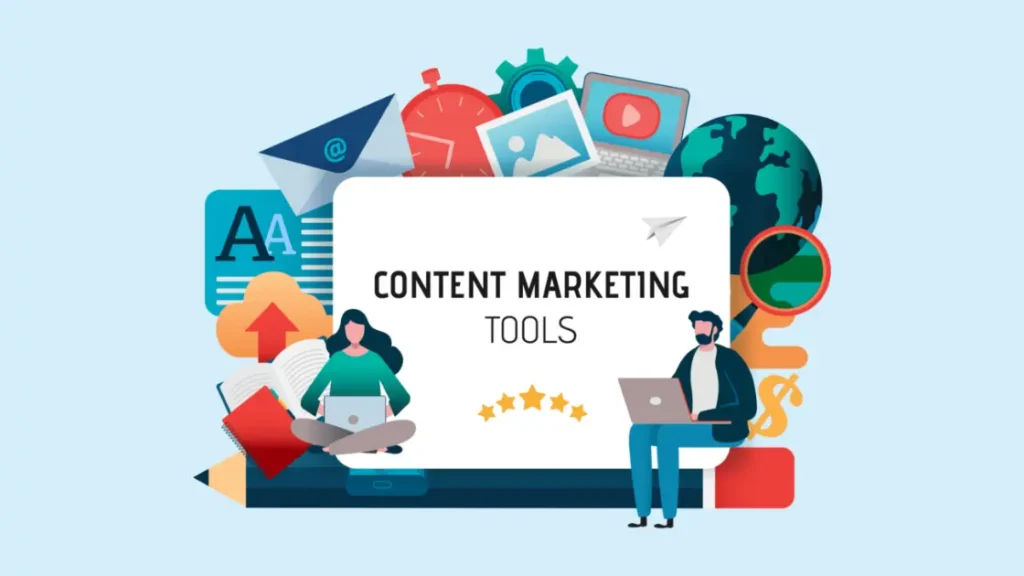
Credit: vh-info.com
Importance of Content Marketing Tools
Content marketing tools are crucial for creating, managing, and optimizing content. They help streamline tasks, measure performance, and enhance productivity. Using the right tools can make a significant difference in your marketing efforts.
Boosting Efficiency
Content marketing tools can significantly boost efficiency. They automate repetitive tasks and save valuable time. Tools like content calendars help you plan and schedule posts. This ensures a consistent publishing schedule.
Additionally, SEO tools assist in keyword research. They help you find the best keywords for your content. Tools like Grammarly and Hemingway improve content quality. They check for grammar errors and readability.
Here’s a quick comparison of popular content marketing tools:
| Tool | Purpose | Key Features |
|---|---|---|
| Grammarly | Grammar Checking | Real-time grammar and spell check |
| Hootsuite | Social Media Management | Schedule posts, track social media performance |
| BuzzSumo | Content Research | Find trending content, analyze performance |
Improving ROI
Effective content marketing tools can improve ROI. They help you track and measure performance. Tools like Google Analytics offer detailed insights. You can see which content performs best.
Moreover, email marketing tools like Mailchimp help segment audiences. This ensures targeted and personalized content. Personalized content often leads to higher engagement.
Here’s a simple list of tools that can help improve ROI:
- Google Analytics
- Mailchimp
- HubSpot
These tools offer valuable insights and enhance content strategies. They help you understand what works and what doesn’t. Investing in the right tools can lead to better returns.
Identifying Your Needs
Choosing the right content marketing tools can be challenging. The first step is to identify your needs. This process helps you find tools that match your goals. Let’s dive into understanding your goals and assessing your current tools.
Understanding Your Goals
Before selecting any tool, it’s crucial to understand your goals. Ask yourself:
- What do I want to achieve with content marketing?
- Do I need to increase website traffic?
- Am I focused on generating leads?
- Is brand awareness my primary goal?
Clear goals help you pick tools that fit your objectives. For instance, if your goal is to boost traffic, you might need an SEO tool. If lead generation is key, a robust CRM could be essential.
Assessing Current Tools
Next, evaluate your current tools. This assessment helps identify gaps and overlaps. Consider the following:
| Current Tool | Function | Effectiveness |
|---|---|---|
| Google Analytics | Website Traffic Analysis | High |
| Mailchimp | Email Marketing | Moderate |
| Hootsuite | Social Media Management | Low |
Review each tool’s effectiveness. Identify areas where your tools excel or fall short. This helps you decide if you need new tools or upgrades.
By understanding your goals and assessing current tools, you make informed choices. This ensures your content marketing efforts are effective and aligned with your needs.
Types of Content Marketing Tools
Content marketing tools are essential for effective digital marketing. They help you create, distribute, and analyze content. Choosing the right tools can improve your strategy. There are different types of content marketing tools. Each type has its specific function. Let’s explore some key categories.
Content Creation Tools
Content creation tools assist in producing high-quality content. They include various tools for writing, designing, and video production. Here are some popular types:
- Writing Tools: Grammarly, Hemingway App, and Google Docs help with grammar and style.
- Design Tools: Canva, Adobe Spark, and Piktochart aid in creating visuals.
- Video Tools: Animoto, Adobe Premiere, and iMovie help in video editing.
Content Distribution Tools
Content distribution tools help share your content across platforms. They ensure your content reaches the right audience. Key tools in this category include:
- Social Media Management: Hootsuite, Buffer, and Sprout Social schedule and manage posts.
- Email Marketing: Mailchimp, Constant Contact, and Sendinblue send newsletters and campaigns.
- Content Syndication: Outbrain, Taboola, and Medium distribute articles to a wider audience.
| Tool Type | Examples |
|---|---|
| Writing Tools | Grammarly, Hemingway App, Google Docs |
| Design Tools | Canva, Adobe Spark, Piktochart |
| Video Tools | Animoto, Adobe Premiere, iMovie |
| Social Media Management | Hootsuite, Buffer, Sprout Social |
| Email Marketing | Mailchimp, Constant Contact, Sendinblue |
| Content Syndication | Outbrain, Taboola, Medium |
These tools can transform your content marketing strategy. Choose tools that match your needs and goals. The right tools can save time and improve results.
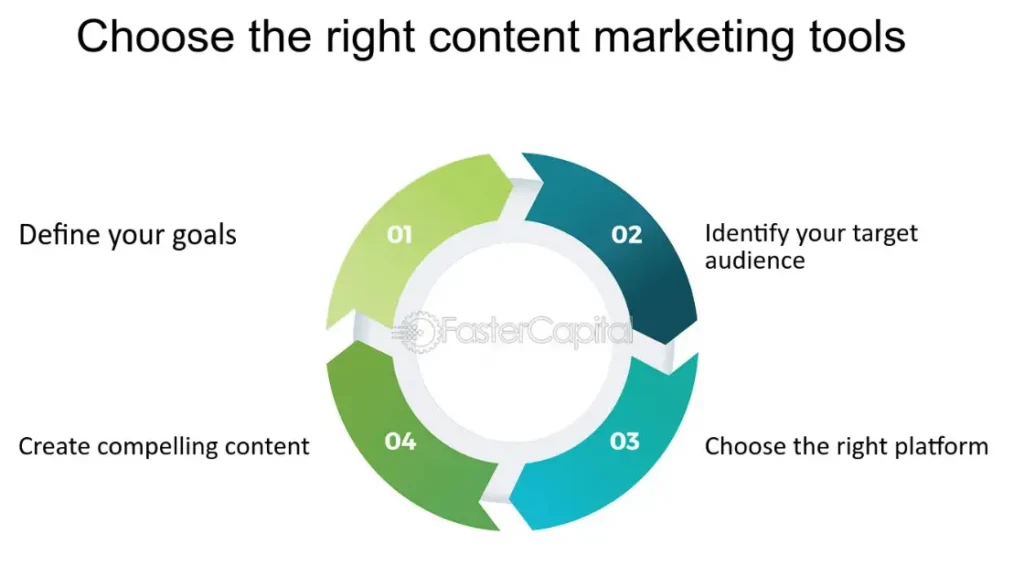
Credit: fastercapital.com
Evaluating Features
Evaluating features is crucial when choosing content marketing tools. It’s important to look at specific aspects that directly affect your workflow and results. Below, we explore two key features: ease of use and integration capabilities.
Ease of Use
Ease of use is a major factor in selecting a content marketing tool. A tool with a user-friendly interface saves time and reduces training costs. Look for tools that offer:
- Intuitive navigation: Can you find what you need easily?
- Clear instructions: Are there tutorials or guides available?
- Customization options: Can you personalize the tool to fit your needs?
If a tool is easy to use, your team can adopt it quickly. They can also become productive faster, leading to better results.
Integration Capabilities
Integration capabilities are equally important. Your content marketing tools should work well with other software you use. This ensures a smooth workflow and better data management. Evaluate a tool’s integration capabilities by considering:
| Feature | Importance |
|---|---|
| API availability | Enables custom integrations |
| Third-party app support | Works with popular apps |
| Data synchronization | Keeps data up-to-date |
Integrations help you connect different parts of your marketing strategy. This leads to more cohesive and efficient operations.
Budget Considerations
Choosing the right content marketing tools can be challenging. Budget considerations play a key role in the decision-making process. Here’s a guide to help you navigate through the financial aspects.
Free Vs. Paid Tools
Both free and paid tools have their own advantages. Free tools are great for beginners. They enable you to experiment without incurring any costs. Paid tools, on the other hand, offer advanced features. These tools often come with better support and more robust functionalities.
Here’s a comparison table to help you decide:
| Feature | Free Tools | Paid Tools |
|---|---|---|
| Cost | Zero | Varies |
| Features | Basic | Advanced |
| Support | Limited | Comprehensive |
| Scalability | Limited | High |
Long-term Costs
Think about the long-term costs of using a tool. Free tools may save money initially. But they might not scale with your business needs. Paid tools often offer better scalability. This means they can grow with your business.
Consider these factors for long-term costs:
- Subscription fees: Monthly or yearly costs
- Upgrade fees: Costs for additional features
- Training costs: Costs to train your team
- Support costs: Costs for premium support services
Evaluating these costs can help you make a smarter choice. Always consider your business’s future growth. Choose tools that can adapt and support your needs over time.
User Reviews and Feedback
Choosing the right content marketing tools can be tricky. User reviews and feedback offer real insights into a tool’s performance. They help you avoid costly mistakes. Read on to learn how to use reviews and recommendations effectively.
Reading Reviews
Reading user reviews can be very helpful. Look for reviews on trusted sites. Pay attention to both positive and negative feedback. This gives you a balanced view of the tool’s strengths and weaknesses.
Here are some tips for reading reviews:
- Focus on recent reviews for the most up-to-date information.
- Look for reviews from users with similar needs.
- Check for common issues mentioned by multiple users.
Seeking Peer Recommendations
Peer recommendations can be invaluable. Ask colleagues or industry peers about their experiences. They can provide honest feedback and practical advice.
Here’s how to seek recommendations:
- Join industry forums or social media groups.
- Post questions about tools you’re considering.
- Attend industry events and network with peers.
You can also use a table to compare different tools based on peer feedback:
| Tool | Peer Rating | Key Features |
|---|---|---|
| HubSpot | 4.5/5 | All-in-one marketing platform, CRM integration, analytics, and reporting |
| Buffer | 4.3/5 | Social media scheduling, analytics, team collaboration features |
| Canva | 4.7/5 | User-friendly design tools, templates for social media graphics, branding options |
| SEMrush | 4.6/5 | SEO tools, keyword research, content optimization suggestions |
| CoSchedule | 4.2/5 | Marketing calendar, social media automation, content optimization |
By leveraging user reviews and peer recommendations, you can make a more informed decision.
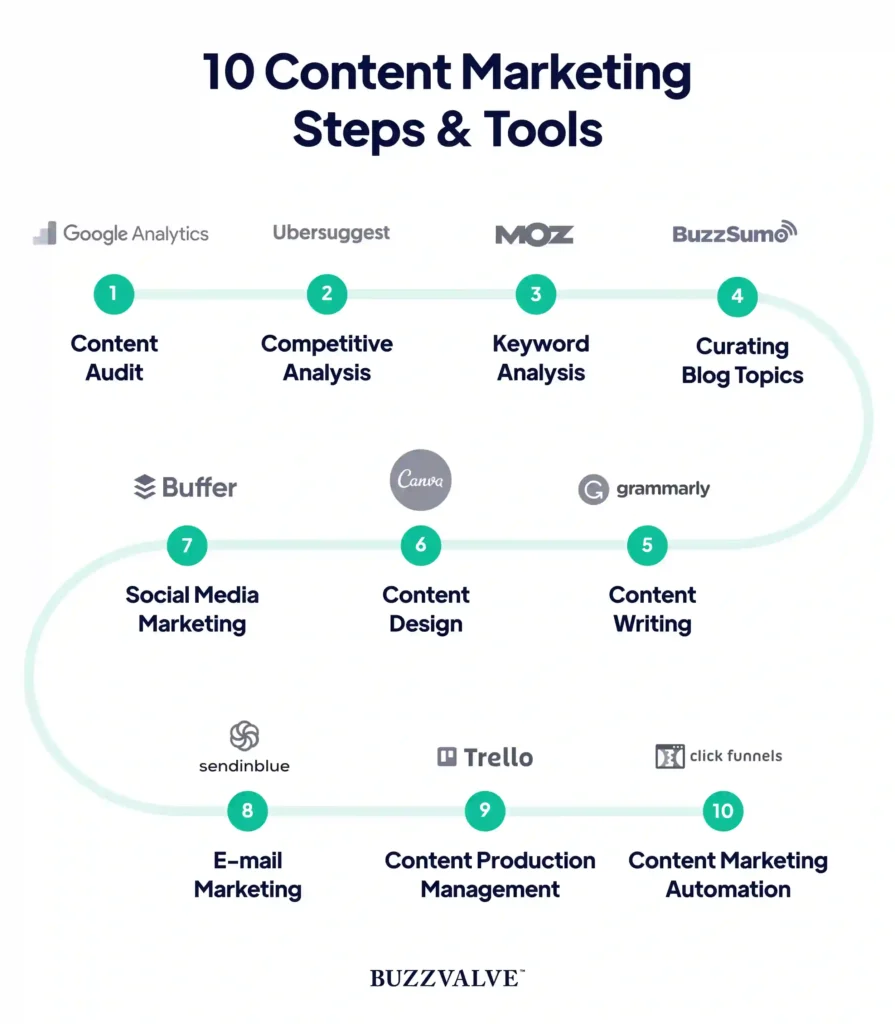
Credit: www.buzzvalve.com
Trial and Testing
Choosing the right content marketing tools can transform your strategy. Trial and testing are crucial steps in this process. They help you understand a tool’s effectiveness before making a commitment. Below, we explore how you can utilize free trials and pilot programs.
Free Trials
Many content marketing tools offer free trials. This is a great way to test features without spending money. You can evaluate the tool’s interface, usability, and functionality. Make sure to check the trial period. Some tools offer 7 days, while others may offer 30 days. Use this time to test as many features as possible.
During your free trial, create a checklist of must-have features. Compare how well the tool meets these needs. Here is a simple checklist you can use:
- User-friendly interface
- Analytics and reporting
- Integration with other tools
- Customer support quality
Pilot Programs
Pilot programs allow for a more extended testing period. They usually involve using the tool in a real-world scenario. This helps in understanding its effectiveness over time. Unlike free trials, pilot programs often have more support from the vendor.
Here is a table to compare free trials and pilot programs:
| Feature | Free Trials | Pilot Programs |
|---|---|---|
| Duration | Short-term (7-30 days) | Long-term (1-3 months) |
| Support | Limited | Extensive |
| Cost | Free | Often free or discounted |
Use pilot programs to test the tool’s scalability. This is especially important for growing businesses. Ensure that the tool can handle increased workload and user demands. Pilot programs also allow for team feedback. Gather input from all team members using the tool.
By utilizing both free trials and pilot programs, you can make an informed decision. This ensures you choose the best content marketing tools for your needs.
Making The Final Decision
Choosing the right content marketing tools can be challenging. Making the final decision requires careful consideration. This section will guide you through weighing pros and cons and aligning with strategy.
Weighing Pros and Cons
It’s important to compare features of each tool. Create a table to make this easier:
| Tool | Pros | Cons |
|---|---|---|
| HubSpot | – All-in-one marketing platform | – Can be expensive for small teams |
| – Excellent CRM integration | – Steeper learning curve for beginners | |
| – Comprehensive analytics and reporting features | ||
| BuzzSumo | – Advanced content discovery and research capabilities | – Higher pricing tiers for full features |
| – Influencer identification and outreach | – Can be overwhelming due to many features | |
| – Robust performance analytics | ||
| Hootsuite | – Advanced reporting and analytics | – Premium pricing |
| – Consolidated inbox for all social accounts | – Cluttered interface | |
| – AI-powered copy generation | ||
| Canva | – User-friendly design interface | – Limited features in free version |
| – Extensive library of templates and graphics | – Some advanced features require payment | |
| – Collaboration tools for team projects | ||
| Jasper | – SEO optimization features for content | – Output often requires editing |
| – Wide range of templates for different content types | – Relatively expensive compared to other AI tools | |
| – Can learn brand voice for consistency |
Consider the features that matter most to your team. Do you need advanced analytics? Or is user-friendliness more important?
Aligning With Strategy
Your content marketing tools must align with your overall strategy. Ask yourself these questions:
- Does this tool support our content goals?
- Can it scale with our growth plans?
- Will it integrate with our existing systems?
These questions will help you determine if a tool fits your strategy. Ensure the tool complements your workflow and enhances productivity.
If your strategy focuses on social media engagement, choose tools that excel in social media management. If SEO is your priority, look for tools with robust SEO features.
Making the final decision involves careful thought. Weigh the pros and cons, and align the tool with your strategy. This will ensure you choose the best content marketing tools for your team.
Frequently Asked Questions
What Are Content Marketing Tools?
Content marketing tools help create, distribute, and analyze content. They improve efficiency and effectiveness. Popular tools include HubSpot, SEMrush, and Canva.
Why Use Content Marketing Tools?
Content marketing tools save time and enhance productivity. They provide insights, automate tasks, and improve content quality. This leads to better audience engagement.
How To Choose The Best Content Marketing Tools?
Choose tools based on your needs and budget. Consider features, user reviews, and integration capabilities. Test free trials before committing.
What Features To Look For In Content Marketing Tools?
Look for ease of use, integration options, analytics, and automation features. Good customer support is also important. Ensure it meets your specific requirements.
Conclusion
Choosing the right content marketing tools can significantly boost your strategy. Evaluate your needs and budget carefully. Research and test various options to find the best fit. The right tools will streamline your efforts and enhance results. Stay adaptable and update your toolkit as new technologies emerge.
Happy content marketing!

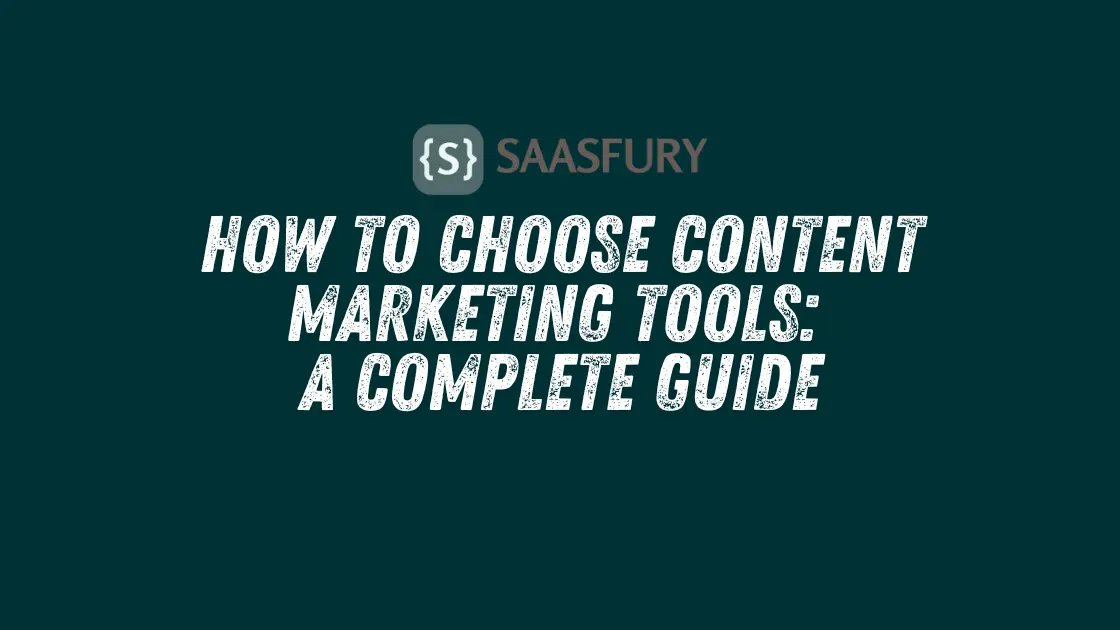
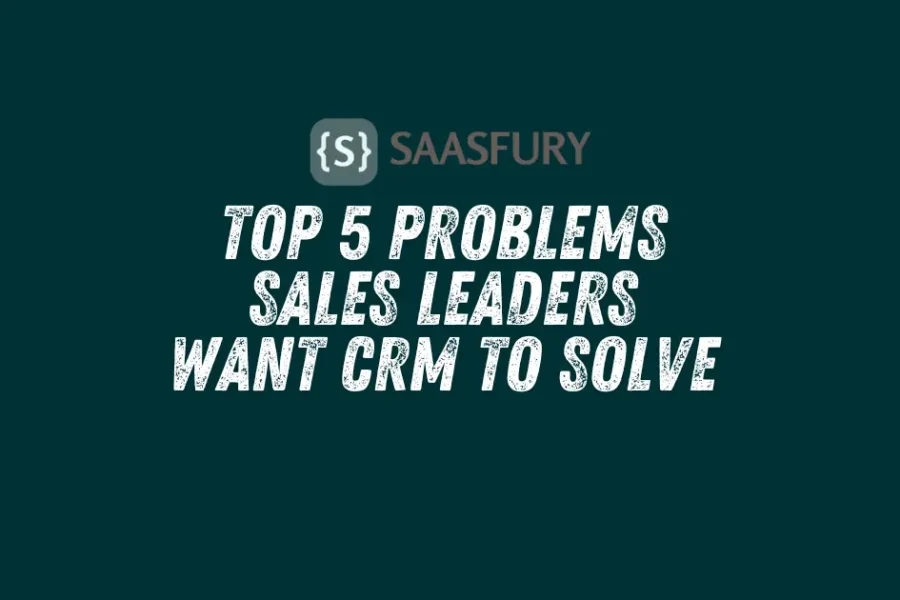
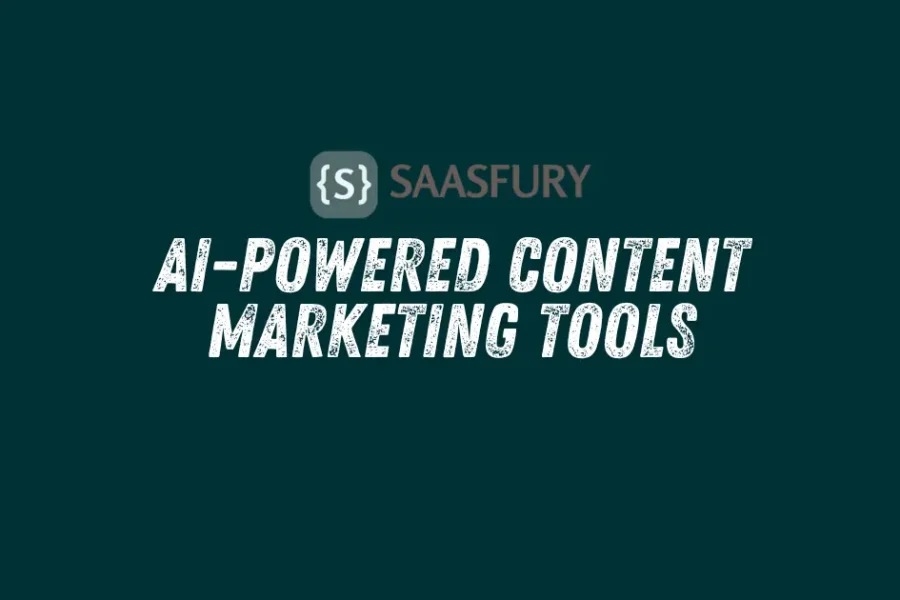
Leave a Comment